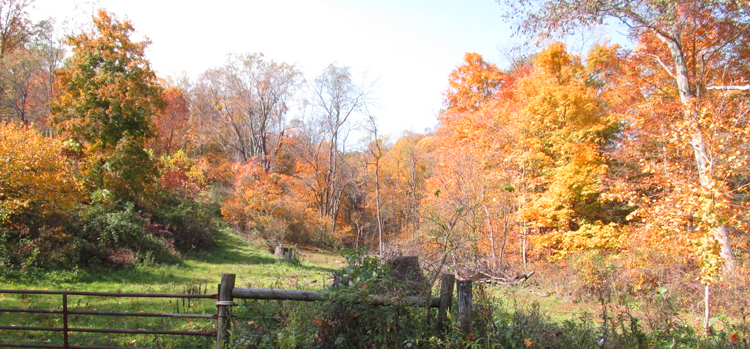It is hard to believe that we started the Betty’s Garden Diary series almost a year ago and that this is our last edition already. In this installment, we will discuss some of the things that we will be doing to prepare for winter and for the garden for next spring. We will reflect on what worked and what didn’t work in the garden this year and then we will finish the series with a few personal thoughts about the year.
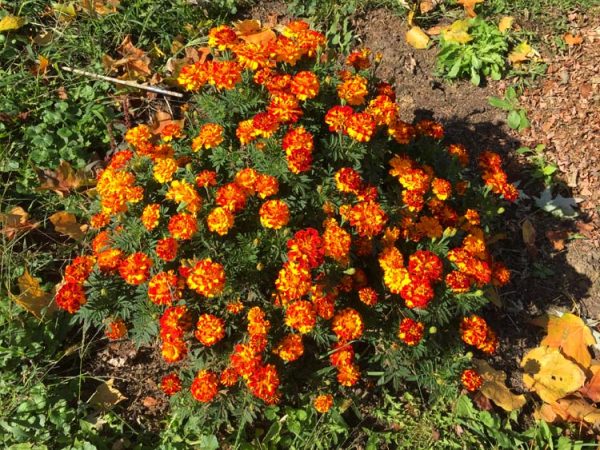
Betty’s Marigolds on Halloween
Somehow, our garden was missed by the frosts that occurred on the mornings of October 13 and October 14 even though we woke up to frost on the railing of our deck and an outdoor temperature reading of 32 degrees at our house. I think the garden was saved by the small amounts rain that had fallen during those two nights and by its location on the hillside which caused air flow even on calm nights. As a result, we still had tomatoes, peppers, sweet potatoes, okra, and cabbages in the garden on October 16. After church on October 16, we dug our remaining potatoes and some of our sweet potatoes. We finished digging the sweet potatoes on October 17. Even though the frost missed Betty’s garden, most of our tomato plants were finished by the middle of October, so we removed and stacked the tomato cages from those. Usually I recommend chopping all of the plant stalks and materials and tilling them into the garden. However, we make an exception for dead tomato plants because they can harbor diseases. If we till the diseased plants into the soil, those disease organisms will be there waiting to infect the next season’s crop. Here in West Liberty, we are permitted to burn brush and other plant materials, so we just pile the old tomato plants up at the lower part of our lot where we burn brush and let them dry out until we can burn them. If you are not permitted to burn brush where you live, then just put the dead tomato plants into your municipal garbage. They will compost at the landfill where they will do no harm. All of our other garden plants are chopped using the lawn mower and tilled into the soil when we do the fall tilling.
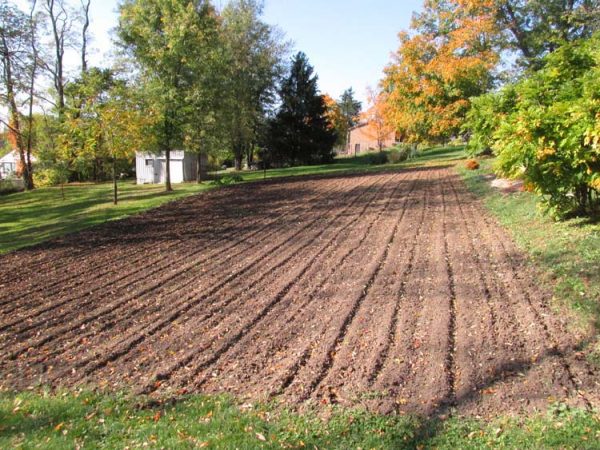
Betty’s Garden on October 25
After all of our crops are finished each fall, we spread the composted leaves from the previous year and then rototill the entire garden. When I do the fall rototilling, I like to leave the garden a little rough with ridges and fairly large clumps of soil. The fall rototilling loosens the soil and incorporates the plant residues along with composted grass clipping mulch and leaves. The fall tilling also eliminates any remaining weeds. Leaving the soil a little rough slows down the speed of the runoff water from the winter and spring rains thereby reducing surface erosion which is a serious concern in Betty’s garden because of the 7% slope.
After the fall rototilling, some folks like to plant a winter cover crop like annual ryegrass or winter wheat. Some people also use legumes like alfalfa or clover because of their nitrogen fixing capacity. Winter cover crops further protect the soil from erosion by either wind or water because they literally cover the soil and hold it in place with their roots. In addition, winter cover crops provide some additional organic matter for the garden when they are worked into the soil in the spring. Cover crop plants also capture and hold a small amount of nitrogen from the soil as they grow, so that nitrogen is added back into the soil when the cover crop is incorporated into the soil. For these reasons, the plant material from cover crops is often referred to as “green manure.” The major disadvantage of cover crops is that they delay the drying of the soil in the spring because the plants consist mostly of water. This is not as much of an issue if you are going to have your garden plowed, but it could delay your spring rototilling by a week or more. For that reason, we have discontinued the use of a cover crop in our garden. If you have followed all of the installments in this series, you will recall that we mulched everything in our garden with about three inches of grass clippings back in May and June. By now, those three inches of clippings have broken down into less than half an inch of composted organic matter which is incorporated into the soil when we rototill it in the fall. As a result, the organic matter content of our soil is quite high especially since we have been using the grass clipping mulch system for several years. We also till in a good quantity of composted leaves. Before doing the fall rototilling, we remove the electric fence and pull out the steel T posts using the little homemade T-Post puller in the picture below. The garden is much easier to rototill without the fence and posts.
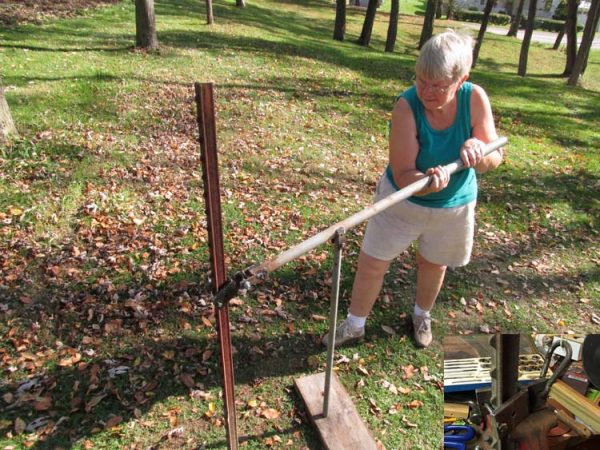
Steel Post Puller
The inset in the lower right shows a close up of the part that grips the steel post. The bolt serves as a pin to catch onto the ribs on the post. The V-shaped gripper is sized so that the pin will slip over the ribs on the post and it will ratchet down the post as it is lowered.
After the garden has been tilled and the fall leaves have been collected and the lawn has been mowed for the last time, it is time to winterize the home power equipment. This is a good time to change the oil in the lawnmower and rototiller. After draining the oil out of the lawnmower, disconnect the sparkplug wire and remove the blade. Last spring, we published instructions for sharpening the lawn mower blade so we won’t repeat those, but sharpening the blade when you winterize your mower helps to ensure that it is ready for action next spring. Clean all of the debris from the underside of the mower. If necessary, use a power washer or water and a wire brush to get it all off. If the underside is rusted or if some of the paint has peeled off, then give it a good coating of spray paint. They actually sell “Non Stick” spray paint for the underside of a mower deck, but we just use whatever partial cans of spray paint that we have on hand. Don’t forget to put in the fresh engine oil and to reconnect the sparkplug wire. Since you won’t be running that engine for several months, remove the gasoline from the tank and then run the engine until it runs out of fuel thereby using up all of the gasoline that is in the fuel line and carburetor. We like to use the run out of gas trick on any power equipment that will not be operated for more than a few weeks. That includes snow blowers, portable generators, rototillers, mowers, lawn tractors, etc.
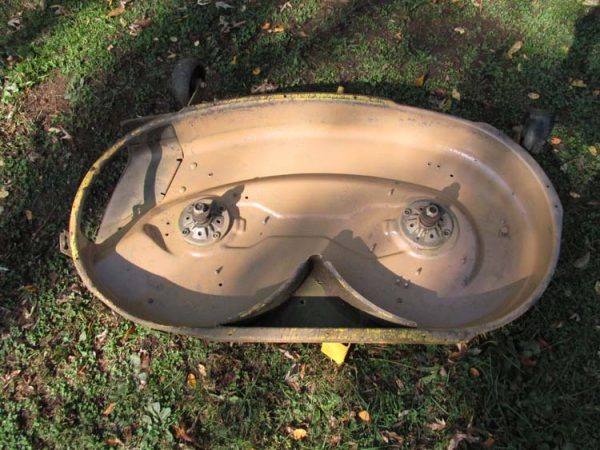
Mower Deck Freshly Spray Painted
After using a power washer to clean the mower deck, we allowed it dry in the sun and then spray painted the underside to deter rust. We had part of a can of brown spray paint on hand, so it is brown!
Let’s talk about gasoline. Modern gasoline contains about 10% ethanol or ethyl alcohol. Most of that ethanol comes from corn grown in America. In fact, the production of ethanol for motor fuel consumes about 40% of the corn grown in the United States. When gasoline containing ethanol is stored for a period of time, the ethanol tends to separate out and to absorb water. In addition, the ethanol attacks some of the plastic parts of the fuel system in your power equipment during the long term winter storage. That can result in the plastic swelling causing choke or throttle valves to stick or blocking the flow of fuel. It may also cause leaks in the fuel system. In addition, the gasoline begins to break down causing sludge to form which can gum up the tiny openings in the carburetor. One solution for the problem is to avoid storing gasoline for any period of time. However, that solution is not always practical. If you own a boat with a built in fuel tank, draining the fuel and running the motor out of gas may not be an option. Besides, how are you going to get out of your driveway to go buy gas for your snow blower when you can’t use the snow blower since you have no gas? Our solution is to use a high quality fuel stabilizer. Usually, I don’t mention brand names, but I will tell you that we use Marine Formula Sta-Bil brand fuel stabilizer for gasoline that we will store for more than a few weeks. I have no brand loyalty to this one, but it has worked so far, so we keep using it. The fuel stabilizer keeps the ethanol from separating out and the gasoline from breaking down for a year or longer.
When an engine has not been run for a long period of time, oil drains from internal parts and moisture can condense thereby causing corrosion. Even a new battery may lose some its charge. Therefore, every engine on every one of your engine powered devices should be ran at least once a month during the winter. This is especially important for snow removal equipment and emergency generators. If you run those every few weeks, then you will know that they are going to start and run when you need them. If they remain totally idle for six or eight months, they may not start when you need them. After you finish winterizing your power equipment, it is a good idea to winterize your garden tools. Before putting those tools away for the winter, clean and sharpen them and wipe a light coat of oil on any parts that are prone to rust. By doing a little work now, you will ensure that everything will be ready for next year.
As we look toward next year’s garden, it is a good time to reflect on the things that worked or did not work this year. As Betty and I discussed this, we realized that our garden this year was one of the most productive that we have ever had in spite of the long periods of dry weather. We decided that writing the “Betty’s Garden” series may have motivated us to give the garden a little more TLC than usual, but we were also richly blessed. Our freezers and canning jar shelves are full.
Here are our totals for the year:
Tomatoes, Salsa, and Tomato Juice – 104 Quarts canned
Green Beans – 87 Quarts canned and 2 Quarts frozen
Pickled Beets – 35 Quarts canned
Sauerkraut – 44 Quarts canned
Dill Pickles – 7 Quarts canned
Mustard Pickles – 10 Quarts in glass crocks
Sweet Corn – 15 Pints canned and 25 Packages frozen
Onions – 9 Packages frozen and 8 bags of whole onions in storage
Okra – Unsure of amount – frozen.
White Potatoes – One five gallon buckets full in storage
Sweet Potatoes – Two five gallon buckets full in storage
By the way, we picked the sweet potatoes and white potatoes into five gallon buckets, but they are stored in open topped cardboard boxes so they can breathe.
This spring, we planted four different patches of sweetcorn so that our sweetcorn harvest would last for a long time. That was two plantings too many. Next year, we will plant the Early Sunglow and one planting of Ambrosia. This year, our potatoes and sweet potatoes were almost an afterthought because we decided to plant them at the last minute. However, they produced bumper crops. The sweet potatoes surprised both of us. Because of that, we are going to plant a full row of sweet potatoes and two rows of white potatoes next year. We planted a variety of cabbage called “Stonehead” this year. It matured early during the dry weather and then the heads began to split when it rained requiring us to harvest it all even though some of the heads were small. Because we had set 30 plants, we got a lot of sauerkraut, but a larger variety like Flat Dutch which resists splitting better would have produced double or triple the amount of sauerkraut. Thanks to the secondary heads on the cabbage plants, we had cabbage for coleslaw through October. Because of the amount of sauerkraut that we canned, we won’t need to make any for a couple of years, so we will order seeds for a couple of other varieties of cabbage so we will have cabbages for slaw all summer. We planted a fifty foot row of cucumbers and then gave away cucumbers to anyone who would take them. We made some mustard pickles and dill pickles, but we had not planted any dill for dill pickles. A friend gave us enough to make the seven quarts. Next year, we will plant less cucumbers and will grow some dill. I love growing zucchinis, but we also gave away as many as we could and still had some go to waste, so we will reduce the number of zucchini plants for next year. I suppose that we should reduce the number of tomato plants also, but I like having several varieties and we enjoy giving the tomatoes to our friends. This year, our Ambrosia sweetcorn did not germinate very well and so added a planting of Candy Corn, but we love the Ambrosia, so we will plant it again next year. Since our garden was so productive this year, we will not need to can tomatoes, pickled beets, green beans, or sauerkraut for a couple of years, so we are planning to downsize Betty’s garden by about one third for next year.
Epilogue – Caution! Some religious content in this section!
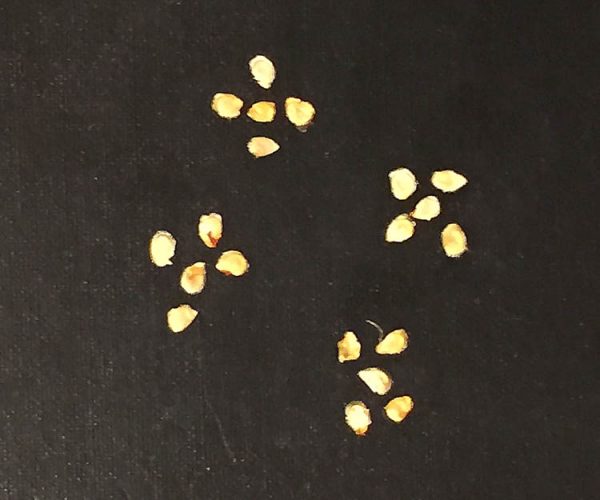
Twenty Tiny Tomato Seeds
The picture above shows twenty tiny tomato seeds. From twenty tomato seeds, we grew the twenty tomato plants that we set out in our garden last spring. We mulched them with grass clippings and put wire cages around them. Then we watered them until they got started. After that, God provided the sunshine and the rain and we harvested enough tomatoes from those twenty plants to can over 100 quarts of tomatoes, tomato, juice, and salsa. We ate fresh tomatoes from early July until late October and we gave away several bushels of tomatoes. All of that came from those twenty tiny seeds. We could make the same observation about what came from the small handful of bean or corn or beet or pepper seeds. I know the science, but one cannot help but to recognize that getting bushels of tomatoes from twenty tiny seeds is a miracle and a gift from God. We can plant and mulch and pull weeds all we want, but we would have nothing without the rain and sunshine. As we approach the season of Thanksgiving, I am reminded of the old hymn:
Come, ye thankful people, come, raise the song of harvest home;
All is safely gathered in, ere the winter storms begin.
God our Maker doth provide for our wants to be supplied;
Come to God’s own temple, come, raise the song of harvest home.
As we conclude this series, Betty and I want to thank each person who has taken time to read our scribbles. We hope that you have found something in this series to be useful and we pray that your Thanksgiving will be joyous and that your Christmas will be filled with love.


